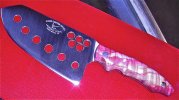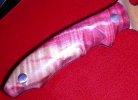- Joined
- Feb 27, 2014
- Messages
- 17,936
Hey guys, just got me some paper wheels and I'm absolutely loving them:thumbup: Now I understand what scary sharp truly means
Anyways...
I've been using the provided white rouge on my slotted wheel with great results.
But what about red rouge? From what I've read, red rouge is a step above white rouge in terms of polishing/finishing, so what if I bought an extra slotted wheel exclusively for red rouge?
Does anybody use red rouge on its own wheel, and how are the results compared to white rouge?
Anyways...
I've been using the provided white rouge on my slotted wheel with great results.
But what about red rouge? From what I've read, red rouge is a step above white rouge in terms of polishing/finishing, so what if I bought an extra slotted wheel exclusively for red rouge?
Does anybody use red rouge on its own wheel, and how are the results compared to white rouge?


